SPORTS

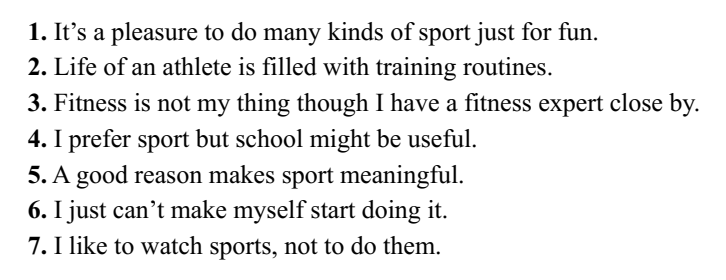


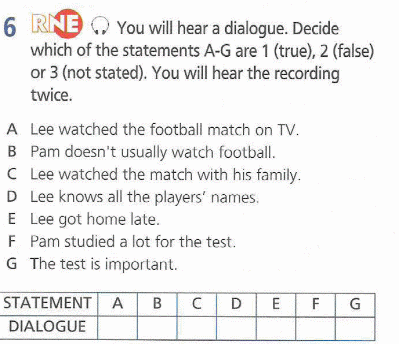



1. Footballers’ diets
2. Ideal football shape
3. Length matters
4. Puree instead of pasta
5. Secret born in the USSR
6. Stress or relaxation
7. Flying fruit
8. Referee’s perspective
A. Good footballers must have something in their genes. Scientists have discovered a link between the length of a footballer’s ring finger and their ability as a player. They compared the ring and index fingers of top players. Players whose ring fingers were longer compared to their index fingers were more likely to be elite players. Some of the players found to have long ring fingers are Bryan Robson, Ossie Ardiles, Glenn Hoddle, Sir Stanley Matthews and Gazza.
B. Fitness training is absolutely necessary for a first-rate football team. Jogging up and down the stadium a few times is not enough. What footballers really need is a quick start. Footballers can get this ability to start running very quickly by using a training method called ‘plyometrics’. In the 1960s, athletes in the Soviet Union used plyometric exercises to improve their results in jumping. Step by step, the method has become very important for many sports that include sprinting and jumping.
C. In the past, footballers used to have a big fried breakfast — or even a roast dinner — before a football match. In the new era of professional football, the menu of modern players has been radically reformed. Arsenal manager, Arsene Wenger, is known for his scientific method of feeding his team. When he first came to the club in 1996, he at once changed the players’ dinner menus. Sugar, red meat, chips, fried foods and dairy products were out. Vegetables, fish, chicken and plenty of water were in.
D. French diet specialists heavily criticised the pre-match diet of the England players in Euro ‘96. Their menu of tomato soup and spaghetti was said to be more likely to produce wind than a win. Potatoes, according to French scientists, make the best meal on the day of a game. They have glucides, which give the player a lot of energy. They also include useful vitamins. According to one piece of research, a player should eat 200-300 grams of mashed potatoes, boiled for 20 minutes, exactly three hours before going to the game.
E. Physics can explain a football wonder — the banana kick. This happens when a ball suddenly changes its direction at the end of its flight. At a certain speed, the air flowing over a flying ball becomes ‘turbulent’. This means that the air moves irregularly over the ball. As the ball slows down, the air becomes ‘smooth’ again. This slowdown makes the ball turn dramatically, creating the wonderful ‘banana’ kicks that the spectators like so much.
F. These days, footballs are made in a design based on the ‘Buckminster Ball’. The American architect Richard Buckminster Fuller came up with the design when he was trying to find a way for constructing buildings using a minimum of materials. The ball is a series of geometrical figures, which can be fitted together to make a round body. The modern football is in fact a Buckminster Ball consisting of 32 pieces. When they are joined together and filled with air they make a perfect sphere.
G. Research has shown that watching the World Cup is good for our health even if your team goes out on penalties. The scientists suggest that a common interest and a nationalistic pride are very important. The competition makes people less concentrated on their own problems. They are also more patient and can cope with crises much easier. Watching football can, however, also be disappointing, especially when it comes to the decisions of referees and officials. Besides, watching penalties can be very nervous


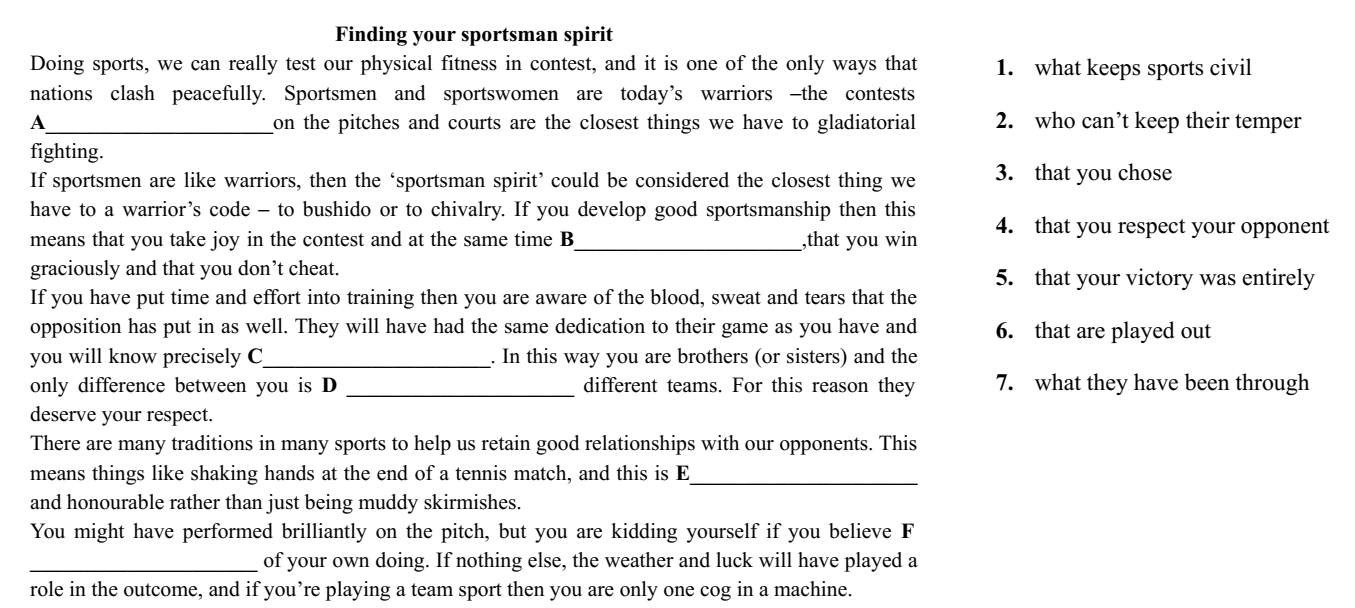


Turning As an Obstacle
When I first read about a sport called parkour, I thought it was about fluid, elegant, and graceful motions. But in practice, parkour is considered an “extreme” sport; as its participants dash around a city, they may vault over fences, run up walls, and even jump from rooftop to rooftop. So you won’t see senior citizens doing it in the park on Sunday mornings, but if you do witness it, you may think you’re watching a stunt person on a movie set.
Le parkour is a French term, related to the verb parcourir, “to run over or through”. It was created by David Belle, Sebastien Foucan, and a group of their friends when they were teenagers living in the Paris suburb in the late 1980s. Belle’s father had been a soldier in Vietnam, and his preparatory programme included navigating obstacle courses. Belle picked up many of the moves from his father and, along with his friends, developed them into an art form.
Parkour combines elements of running, gymnastics, dance, and martial arts into a breathtaking way of moving from place to place. The general idea is to move quickly and gracefully, treating buildings, walls, handrails, rocks, and whatever objects you come across as elements in an obstacle course. The only real rule is that you should not move backwards and that you should do it with as much efficiency and style as possible.
The only equipment required for parkour is a good pair of shoes. Participants, who call themselves traceurs, wear no protective gear but typically invest a great deal of time in training and preparation in order to execute the necessary moves safely. The first thing any participant learns is how to cushion the impact of a jump by rolling. Although parkour is ultimately about clever improvisation rather than choreographed moves, there are a couple dozen or so standard maneuvers that almost all traceurs learn, including several methods for getting over tall walls.
Some traceurs participate merely for the fun or the challenge, but others treat parkour as a more serious art, similar to some martial arts. As a philosophy, the movements metaphorically represent becoming one with your environment, learning how to overcome obstacles without effort, and finding creative paths – all things with practical value outside the sport.
Even though parkour has reached international popularity, there is already an offshoot sport that has led to a great deal of bitterness and division among parkour proponents. Co-founder Sebastien Foucan, in a 2003 BBC documentary called “Jump London,” referred to the sport as “free-running” and that term caught on in the media. However, parkour purists feel that the direction in which Foucan has taken the activity is entirely different from what he and Belle had originally developed.
The biggest difference has to do with theatrics. Free-running involves a lot of trick moves, particularly mid-air flips and spins. Because these moves are merely showy, not economical, they’re considered contrary to the nature of parkour. A free-runner may also move backwards in order to make a move as flashy as possible.
But it’s not simply a matter of differing styles. Manufacturers are capitalizing on the growing interest in parkour and free-running by introducing special shoes, designer clothing, and so on; free-running competitions are also beginning to appear.





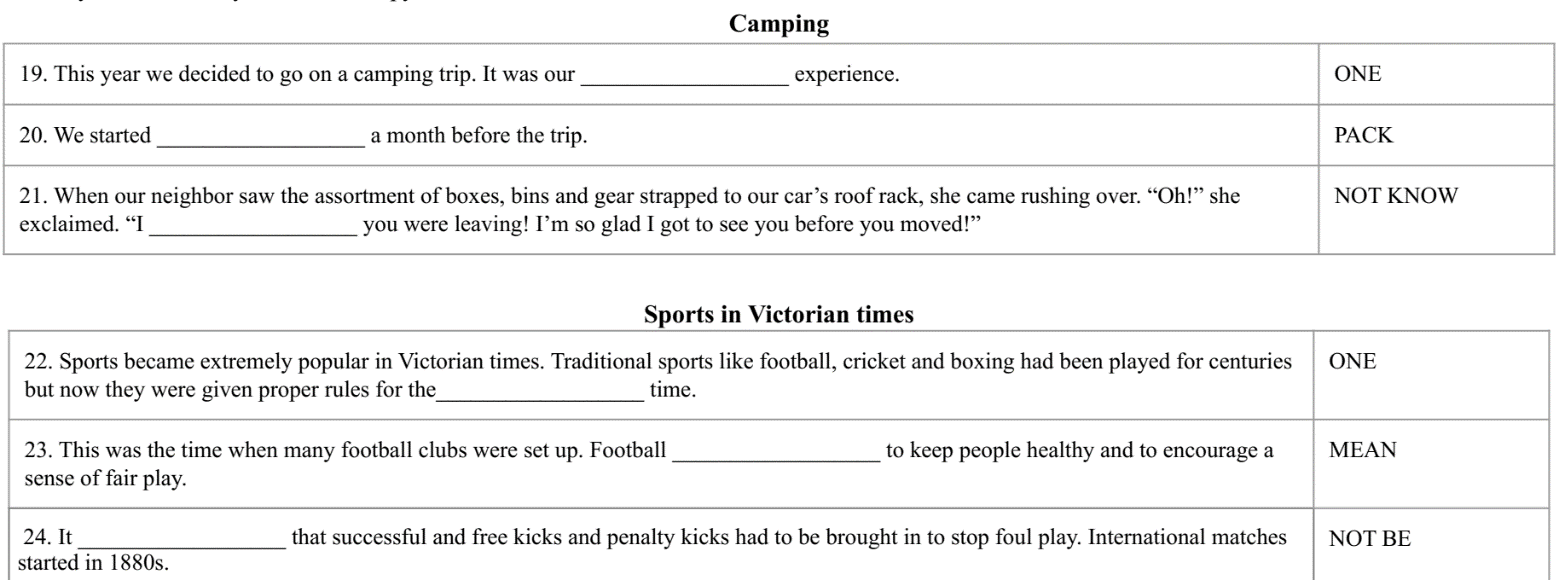





29
28
27
26
25


A famous athlete
Victoria Green is a tennis player who holds the most combined major titles among active players. But how did she 30 ______ to get all of those cups? She dominates the court with her strength and agility. Her serve is 31 ______ one of the best serves in women's tennis history. She serves with power and places the ball with accuracy. At Wimbledon in 2010, Green not only won the tournament, but she also 32 ______ the tournament's record when she served 100 aces throughout her matches in the tournament!
Green uses her mental strength and resilience to win tennis matches. Victoria has made incredible comebacks in her career. In the 2013 US Open Final, she was losing to her opponent towards the end of the game. 33 ______ she was two points away from losing the whole match, Green did not give up. Finally, she made a comeback and won the championship! Her victories in high-pressure tournaments illustrate her remarkable focus and 34 ______.
Victoria Green continues to play professional tennis and also runs her own businesses. She has been on the cover of many popular magazines. She has also created her own charitable organization that 35 ______ educational opportunities for underprivileged youth around the world. Victoria Green 36 ______ young people that they can accomplish their dreams through hard work and dedication.
30.
1) manage
2) achieve
3) complete
4) succeed
31.
1) concerned
2) considered
3) convinced
4) confessed
32.
1) broke
2) crashed
3) pushed
4) fought
33.
1) However
2) Nevertheless
3) Moreover
4) Although
34.
1) appreciation
2) expectation
3) admiration
4) determination
35.
1) predicts
2) pretends
3) provides
4) permits
36.
1) reviews
2) reminds
3) revises
4) remembers

...Our basketball team has won the championship! Wow! I'm so happy! What sports are popular in your country? What sports do you practice? Would you like to become a professional athlete and why or why not?...
...I went to a fabulous museum during my school trip and I wish I could go there again...
Write a letter to Kevin.
In your letter:
- answer his questions
- ask 3 questions about the museum.
Write 100–140 words.
Remember the rules of letter writing.
38. Imagine that you are doing a project on why young Zetlanders do extreme sports. You have found some data on the subject-the results of the opinion polls (see the table below).
Comment on the data in the table and give your opinion on the subject of the project.
| The opinion poll question: Why dom you do extreme sports? |
| Motives | Number of young athletes (%) |
| To get some adrenalin | 49 |
| To follow modern trends | 17 |
| To increase self-confidence | 13 |
| To fight fears and stress | 12 |
| To explore one's limits | 9 |
Write 200-250 words.
Use the following plan:
— make an opening statement on the subject of the project;
— select and report 2–3 facts;
— make 1–2 comparisons where relevant and give your comments;
— outline a problem that can arise with doing extreme sports and suggest a way of solving it;
— conclude by giving and explaining your opinion on the role of extreme sports in the lives of young people.
SPORT
| LISTENING | READING |
| 1 | 156374 | 10 | 3514728 |
| 2 | 2133132 | 11 | 647315 |
| 3 | 2 | 12 | 2 |
| 4 | 1 | 13 | 1 |
| 5 | 3 | 14 | 4 |
| 6 | 1 | 15 | 3 |
| 7 | 2 | 16 | 3 |
| 8 | 2 | 17 | 3 |
| 9 | 1 | 18 | 1 |
| GRAMMAR |
| 19 | FIRST | 28 | TRAINING |
| 20 | PACKING | 29 | SERIOUSLY |
| 21 | DIDNOTKNOW | 30 | 1 |
| 22 | FIRST | 31 | 2 |
| 23 | MEANT | 32 | 1 |
| 24 | WASNOT | 33 | 4 |
| 25 | SUCCESSFUL | 34 | 4 |
| 26 | IMPRESSIVE | 35 | 3 |
| 27 | SWIMMERS | 36 | 2 |
Ready to start.
Speaker A. Sport is one of my favorite activities. I love running, swimming, playing tennis, doing gymnastics. When I was little, my parents took me to the pool and I learned to swim. I learned to play tennis myself, and now I am good at it. But I never wanted to be a famous athlete. It's just too much work. I simply do sport to feel well, to have energy, and to keep fit. I love it how a good run in the morning gets me focused for the day.
Speaker B. You see, I run marathons for charity. It's become quite popular now, you know. I started by walking a marathon distance first, but now I can run it and even make good time. My last marathon I ran in the mountains on International Women's Day to raise awareness for women's rights. Though I really like running, a marathon cause gives me more motivation to train. It's like I know I am making a small change in some huge problem by simply running.
Speaker C. I've wanted to start exercising for years, but it just doesn't happen. In the morning, I can't seem to make myself get up early to go to the fitness center before school, and after school I feel too tired and hungry. I am so busy with schoolwork that it just seems impossible to find the time for anything else. I guess I really would like to be more fit and energetic, but I don't know how to begin. Some of my friends go to a fitness club, but I haven't gone yet.
Speaker D. You know, my brother is a personal trainer at a fitness club. He helps people keep in shape by choosing the correct fitness plan for them. He has these books of exercise routines for all different types of people. He interviews his clients when they first hire him, and he sets goals for them. Some of the people take his help very seriously, yet other people look at his work skeptically and prefer to make their own plans. He wanted to make a plan for me, but I said no.
Speaker E. Oh, I love sport! Watching it, not doing. I am ready to go to a stadium any day and watch a football match or a game of hockey. My favorite channel is the sports one. It is always on when I am at home. Um, I watch all kinds of sports, but my favorite is cross-country skiing. I know all the leading athletes on the different teams and really get into cheering our country's team on. My mom often says I should go skiing myself, but I prefer the sofa.
Speaker F. My dad is always saying that I should spend more time behind books, but what can I do? I really love to play football. I can't learn geometry when I hear a bunch of guys outside having a good time playing ball. I drop all of my homework and I'm out of here. I tell my dad I might be the next Ronaldo or Beckham, but I don't think he sees any future in that for me. He says even football players need to be intelligent. Who knows, maybe he does have a point.
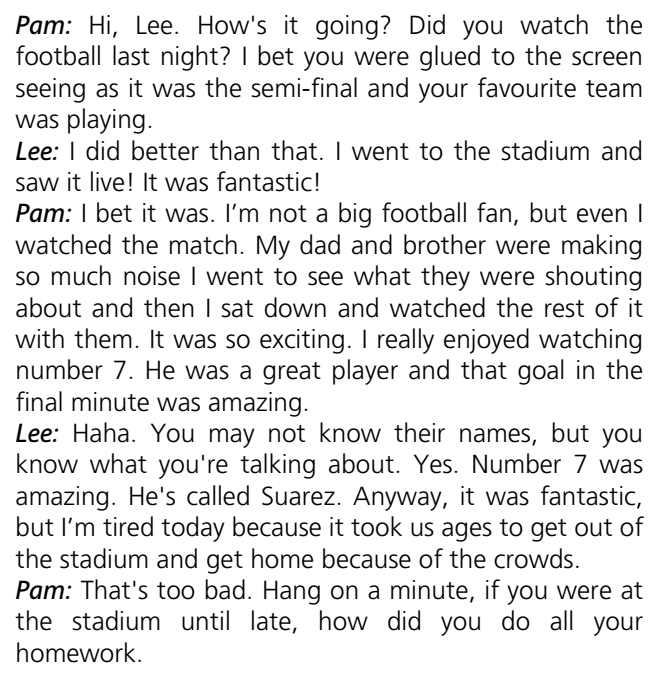
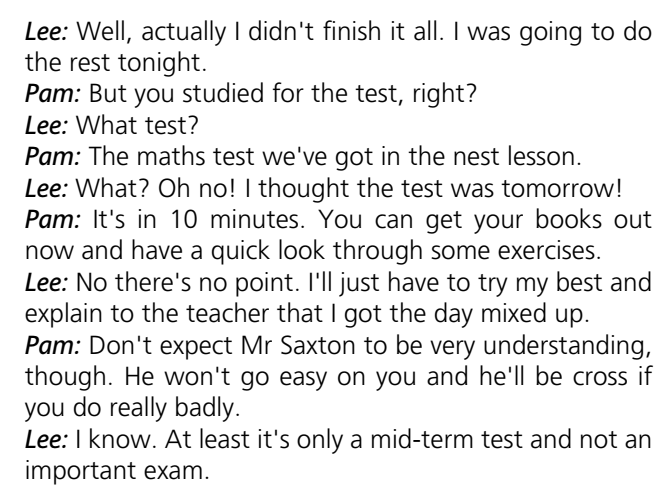
3-9
Our program about extreme sports is on, and today we're going to learn about scuba diving. Our expert is Barbara Green, who owns a diving school.
Hello everybody.
Barbara, what's the difference between diving and scuba diving?
The word scuba stands for a self-contained underwater breathing apparatus. That's the basic difference. Knowing how to scuba dive opens up an entire underwater world of coral, fish, and other creatures. You can even say hello to a shark. That's a joke, though. People say once you've tried scuba diving, you'll never forget it. Is that true? Imagine swimming in clear, blue waters as you look at brightly colored fish and striking shapes of coral organisms. The underwater world is quiet, except for the sound of your breathing. Can you ever forget it? Would you like to go back and see it again? I guess that's the answer to my question.
I hear scuba diving needs a lot of stuff and can be expensive.
Scuba diving requires several pieces of important equipment, which can be relatively expensive. Scuba divers must wear a mask in order to see underwater. The mask creates an air space that protects the eyes and nose. Divers wear scuba fins on their feet. Without them, it's impossible to move easily and quickly through the water. Many divers also wear a wetsuit to stay warm underwater.
Is scuba diving dangerous?
Basically, no, but the ocean demands respect. Divers wear a BCD, or buoyancy control device, to control how much they float or sink. A pressure gauge device tells divers how much air is left in the air tank. Or a dive computer can calculate how much air is left as well as a diver's depth and the length of time they can stay underwater. Scuba divers breathe with a regulator, which brings air to the mouth when they inhale. The regulator is attached to an air tank that is placed on the diver's back. There is also an extra regulator called an octopus. It's used in case of emergency situations.
I know decompression sickness is a great problem for divers.
You are right. It is a major concern for divers. The deeper a diver goes, the more pressure the surrounding water puts on the volume of the air inside his or her lungs. And the deeper a dive, the more nitrogen gas goes into the diver's blood.
Do you teach it in your school?
Of course. To learn how to use all this equipment, it helps to go to dive school. Becoming a certified diver requires three series of lessons. New divers must learn about the physics and safety of diving and practice diving skills first in a closed water area and then on actual beginner dives. Several organizations offer official diving certifications.
Do people dive alone apart from the instructor?
Another important aspect to diving is having a buddy system. Having a diving partner you can watch over one another and help if there's an accident.
Any final comment from you?
One important diving rule is to never touch any of the sea life. This rule is to protect both the diver and the underwater environment. For example, there's a reason fire coral received its name. It causes a painful burning feeling if touched. A diver could also be cut by touching a sharp piece of coral. It may seem hard like stone, but it's actually a very fragile organism. It can be damaged if divers touch or stand on it. To protect the beautiful coral reefs, divers must treat them with care. Sorry to say, tourists often forget about this.
Thank you. You have 15 seconds to complete the task















































